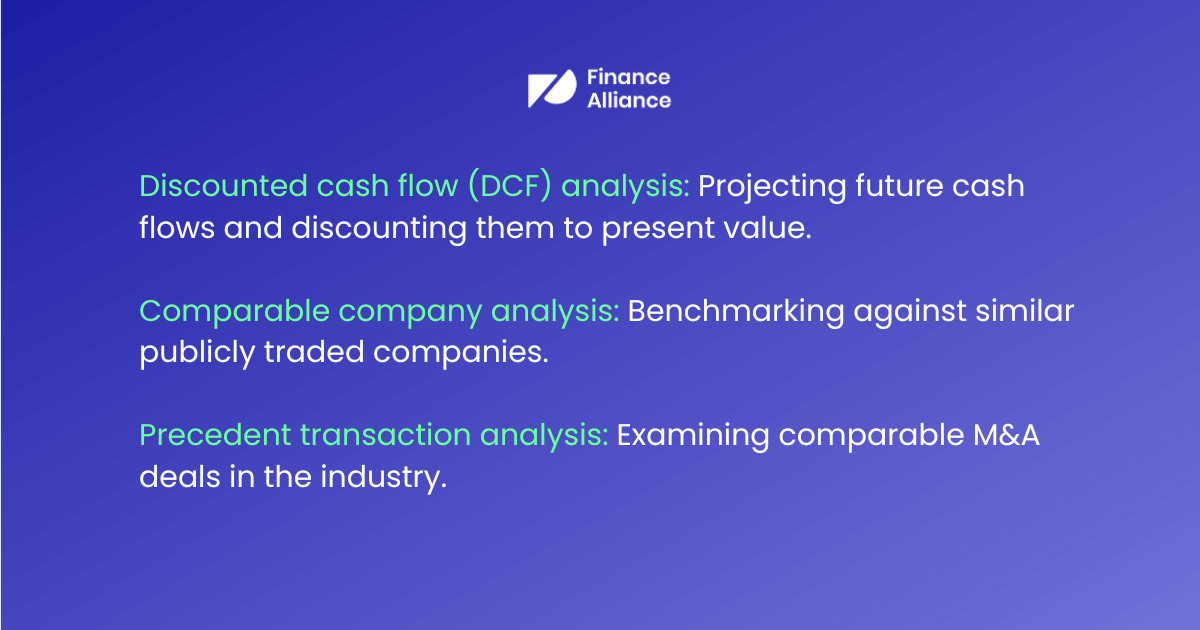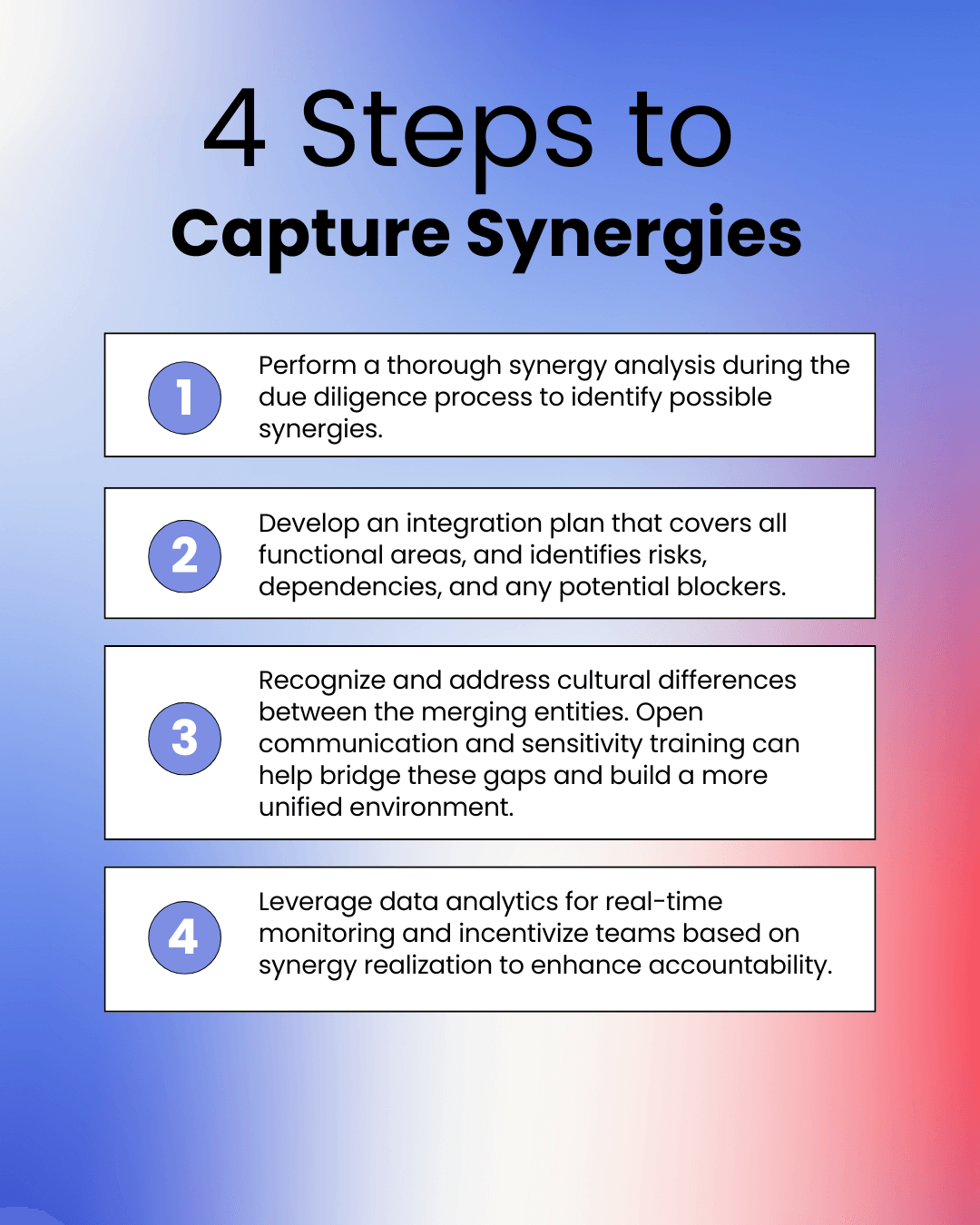Mergers and acquisitions (M&As) can either propel your company to new heights… or plunge it into complete chaos.
The stakes are high in any M&A deal, but don’t that let that knock your confidence. With careful preparation and a strategic approach, you can lead a smooth transition.
To help you do just that, we’ve compiled this guide outlining 10 M&A risks of acquiring a company – and more importantly, how to mitigate them.
This guide covers:
- The difference between mergers and acquisitions
- Types of M&As
- 10 risks of mergers and acquisitions
- FAQs
Merger vs acquisition: What’s the difference?
Mergers and acquisitions (M&As) are intertwined in many ways, but there's a key distinction between the two:
What is a merger?
A merger occurs when two companies join forces to create a single, new company. Both companies combine their assets and liabilities. The existing companies essentially dissolve, and a new company is created.
What is an acquisition?
An acquisition is when one company (usually the larger of the two) takes over another company or a portion of another company. The acquired company (including its assets and operations) becomes part of the acquiring company, like a subsidiary or division. Acquisitions usually come about when one company expresses interest in acquiring the other.
Types of M&As
If you thought M&As are straightforward, think again. They actually come in different forms, and each has a strategic purpose and possible implications.
Knowing the different types of M&As can help you navigate the complexities that come with them.
![Types of M&As [M&A risk blog post]](https://www.financealliance.io/content/images/2024/05/Types-of-mas.png)
Here’s some more information about each of the main types of M&As and when they’re most likely to happen:
1. Horizontal mergers
This type of merger occurs between companies operating in the same industry. It usually takes place between direct competitors that offer very similar products or services. The most common reasons for a horizontal merger include:
- Consolidating market share
- Reducing competition
- Achieve economies of scale
2. Vertical mergers
A vertical merger happens between companies at different stages of the supply chain. A common example would be something like when a manufacturer decides to join forces with one of its suppliers.
These unions are all about:
- Streamlining the production process
- Cutting costs
- Eliminating the middle players
- Gaining more control over the supply chain cycle
3. Conglomerate mergers
Conglomerate mergers are slightly different because they happen when companies from unrelated industries and/or business activities join together. These can usually be split into two sub-categories:
- Pure conglomerates (completely unrelated businesses)
- Mixed conglomerates (some related and some unrelated businesses)
This type of merger tends to occur when companies want more diversification. By spreading their bets across multiple industries, companies can reduce their overall risk if one sector hits a rough patch.

4. Market-extension mergers
Sometimes companies that sell similar products decide to join forces, but not because they're competitors. Market-extension mergers happen when these companies are operating in completely different markets or regions.
The two main reasons why companies would want to pursue market-extension mergers are:
- Expand their market reach
- Grow their customer base
5. Product-extension mergers
The final type of merger we’ll cover in this guide is the product-extension merger. This often occurs between companies that sell different but related products in the same market.
Product-extension mergers help companies broaden their product lines and offer complimentary products to their customers.

10 risks in mergers and acquisitions
These 10 risks have tripped up many companies going through a merger or acquisition, which is why you not only need to be aware of them, but know how to overcome them.
So, keep these 10 M&A risks in mind as you navigate your deal:
1. Overvaluing the target company
We've all heard the saying, "Don't bite off more than you can chew." Well, that's especially true when it comes to M&As.
A study by Harvard Business Review found that between 70% and 90% of M&A deals fail every year and you can bet that overvaluation is a major culprit.
Overvaluing the target company can lead to overpayment and reduced return on investment (ROI), putting a strain on your finances.
Overvaluing in the M&A process usually comes down to:
- Overly optimistic projections
- Inadequate due diligence
- Failure to account for potential market shifts
- Pressure to close quickly
- Emotional attachment to the deal
- Turning a blind eye to negative findings
These factors can cloud judgment by placing too much weight on the target company’s best-case scenarios and growth assumptions.
There’s nothing wrong with having a positive outlook, but this optimism bias can lead to overlooking potential risks and challenges that could be detrimental to the deal.
To mitigate this risk, make sure you give the target company a thorough and objective evaluation. This means looking at its past performance and future potential.
Use different valuation methods like:

And remember, pursuing independent valuation never hurts. External financial advisors can offer an unbiased perspective, reducing the risk of overpaying. If the deal isn't adding up, don't be afraid to walk away.
2. Inadequate due diligence procedures
Poor due diligence is one of the most common acquisition risks. The problem is that it gives you a false sense of security, only to reveal the truth later in the form of unforeseen liabilities, financial misrepresentations, and operational challenges. All of these can then lead to more issues like significant financial losses, damaged reputation, and costly lawsuits.
Here are some strategies to help sidestep these issues:
🗂️ Make your due diligence process as comprehensive as possible. It should be multi-faceted and consider the target’s financial health, operational efficiency, legal standing, and strategic alignment with your company.
🤝🏽 Consider assembling a multidisciplinary team of both internal and external experts to ensure a thorough assessment. We’re talking accountants, lawyers, industry specialists, and HR professionals to uncover potential risks across different areas – leave no stone unturned!
🔎 Keep monitoring and assessing risk as new information comes to light. As negotiations progress and new information surfaces, continuously assess risks, adjust your strategy, and implement mitigation measures as needed.

3. Limited owner involvement
It might seem like an obvious necessity for a successful M&A, but you’d be surprised at how many owners take a step back during the process. This can happen when the company has paid for some type of M&A advisor and some owners will assume the hired help has everything under control.
However, owners should be involved throughout the entire process. Owners need to be involved because they hold a wealth of knowledge about things like the company’s history, market dynamics, and customer base. Sidelining them can lead to overlooking critical factors that could impact the integration's success.
If it’s a case where the owner of the target company feels excluded, they might resist the imposed changes, which can cause cultural clashes within the combined entity.
Another issue is when the owner is very disengaged and fails to support the integration process as needed. Their employees, noticing the owner’s lack of advocacy and guidance, can quickly lower morale and productivity, which can slow down the entire integration timeline.
To help mitigate this M&A risk, put these things in motion:
- Build clear communication channels with the owners from the very beginning of the deal. Keep them informed of the M&A process, address their concerns openly, and actively solicit their input.
- Seek the owner’s advice on things like product development, customer relations, and so on. Remember, they have unique knowledge of the company, knowledge that you definitely want to obtain before the deal closes.
- Acknowledge the emotional significance of the M&A for the owner and emphasize the positive aspects of the deal, such as growth opportunities and a secure future for their employees.
4. Missed opportunities for capturing synergies
A stark contrast emerges when examining synergy capture in M&A deals. According to PwC’s report, ‘Success factors in post-merger integration,’ companies that achieve successful integrations see a significantly higher rate of synergy realization – over 83% – compared to less successful acquirers, where less than half (47%) manage to capture the anticipated synergies
This shortfall can lead to underwhelming financial performance and a diminished return on investment (ROI) for the acquiring company.
To make sure you capture synergies properly, there are a few steps you can take:

5. Integration failures
When two companies struggle to integrate, they can miss out on the reasons why the deal was agreed to in the first place such as cost savings through streamlined operations and boosted market share through combined customer bases.
It’s not just operational integration issues either, many companies also fail to integrate culturally too. McKinsey states that 95% of executives describe cultural it as vital to the overall success of integration. However, 25% cited a lack of cultural cohesion and alignment as the number one reason integration efforts fail.
PwC’s M&A Integration Survey revealed even more insights into the importance of integration in a successful M&A deal. Here are a few highlights from their report:
60% of companies are now developing their long-term operating models before due diligence begins.
75% of successful acquirers report extensive experience in these complex transactions, compared to only 43% of other respondents.
59% of companies spent 6% or more of deal value on integration.
To help navigate issues related to M&A integration, remember to focus on people, not just processes. If you want the M&A to be a success, you need your team to be motivated and supported during the entire process.
So, develop a talent retention strategy to prevent key employees from jumping ship. Create opportunities for collaboration between the merging teams, encouraging knowledge sharing and fostering a sense of shared purpose.
6. Security concerns
While companies aim to combine strengths, the M&A process itself creates vulnerabilities and can leave companies open to security threats. There are a few reasons for this such as:
- Sensitive data exchange during due diligence opens new attack points for hackers.
- Integrating disparate IT systems can leave temporary gaps in security.
- Disrupted workflows and employee focus during the transition can further weaken defenses.
Forescout’s study into the role of cybersecurity in mergers and acquisitions revealed that 53% of their respondents stated that their companies experienced critical cybersecurity issues during the M&A process, which imperiled the deal negotiation.
Deloitte emphasizes the importance of being secure, vigilant, and resilient before, during, and even after the M&A process, stating:
“Being secure means having risk-prioritized controls to defend against known and emerging threats.
“Being vigilant means having threat intelligence and situational awareness to identify harmful behavior.
“Being resilient means having the ability to recover from, and minimize the impact of, cyber incidents.” – Deloitte (Role of cybersecurity in M&A)
To tackle these issues head-on, prioritize:
- Security-first due diligence - Don't just assess financial health – evaluate the target company's cybersecurity practices.
- Phased integration with security at the forefront - Develop a phased integration plan that prioritizes security throughout the process.
- Maintain vigilance during disruption – Maintain regular security awareness training for employees. Allocate sufficient resources for IT teams to monitor for suspicious activity and remain vigilant against cyber threats.
- Third-party vetting - Thoroughly vet any third-party vendors involved in the M&A process. Ensure their security protocols meet your standards and pose no additional risks to your combined data security posture.
By taking these proactive measures, you can help mitigate the cybersecurity risks associated with M&A deals and ensure a smooth and secure integration process.

7. Unforeseen costs
Bain & Company reported that the global M&A market has recently dropped by 15% to $3.2 trillion (the lowest level in a decade). One of the main reasons for the drop was associated costs related to closing M&A deals.
It’s not an entirely new concept though. Surprise expenses can often pop up during M&A transactions like unexpected integration costs, legal fees, or regulatory penalties.
Bain & Company shared that 95% of their respondents agreed that rising interest rates have made them adapt their M&A strategy. The survey found the biggest change (cited by two-thirds) was companies being choosier about the deals they went after.
To avoid hidden or unexpected costs, set up a financial safety net to cover unforeseen expenses and run scenario analyses to prepare for potential risks.
Also, try to keep communication lines open with legal and regulatory authorities to spot potential compliance issues early, which will allow for proactive planning and cost management.
8. Litigation risks
One of the biggest risks of an M&A deal is related to litigation threats from various stakeholders like shareholders, regulators, employees, and competitors.
Some common areas of litigation include:
- Shareholder lawsuits alleging breach of fiduciary duties, inadequate disclosures, or unfair deal terms.
- Antitrust challenges from regulatory bodies over potential monopolistic behavior or reduced competition.
- Employee lawsuits related to compensation, benefits, or workforce reductions.
- Intellectual property disputes with competitors over patent infringement or misappropriation of trade secrets.
Litigation can disrupt and delay the M&A process. Worst-case scenario, you could end up with the termination of the deal. And even if the lawsuits are eventually dismissed, the legal fees, management distraction, and reputational damage can be hard to recover from.
It’s important to put processes in place to mitigate these risks carefully. For example, you might want to:
- Conduct a thorough IP review.
- Partner with antitrust experts and regulatory advisors early on.
- Make sure the deal terms are fair and reasonable for everyone involved.
- Explore M&A-specific insurance policies, such as representations and warranties insurance, to transfer certain litigation risks to insurers.
- Involve experienced M&A legal counsel throughout the process.
9. Insufficient communication and transparency
Poor communication and lack of transparency during M&A can cause confusion, mistrust, and resistance among employees and stakeholders. It's easy to overlook this risk. But it can have a significant impact on the success of the transaction.
Unfortunately, communication is an issue that’s often overlooked during mergers and acquisitions.
Financier Worldwide magazine talked about this issue in detail in a past issue:
“While the deal team and management are rushing to get the deal signed and announced, they cannot lose sight of internal communication." - Josh Hochberg, Deputy General Manager of Financial Communications at Edelman.
Another great quote from the same feature emphasized the importance of keeping everyone in the team in the loop. As noted by Nicole Alvino, co-founder and Chief Strategy Officer for SocialChorus:
“During times of change, companies need to reach all employees with the right information at the right time.
"If a company does not have an M&A communication plan in place, it can leave employees uncertain and misinformed.”
To help maintain proper communication during an M&A deal, you need to build a solid M&A communication plan that covers key messages, channels, and a schedule for updates.
So, how can you create something like this?
You can start by defining your objectives for the plan. This could be something like managing expectations or maintaining transparency. Once you’ve got that locked in, move on to identifying key stakeholders such as:
- Employees
- Management
- Customers
- Suppliers
- Investors
Then, develop a strategy that includes clear, consistent messages tailored to each group. Don’t stick to one communication channel but make sure to incorporate a blend of channels like emails, meetings, and press releases to make sure everyone is informed.
From there, you can make a clear plan for communicating before, during, and after announcing the merger. Ensure two-way communication by setting up feedback channels and scheduling regular updates to address concerns.
Once the plan is in motion, pay close attention to how it’s going over with stakeholders. Gather feedback through surveys, online forums, or just informal conversations. If people seem confused, frustrated, or have a lot of the same questions coming up, that's a sign you’ll need to make some changes to your approach.
Make sure your managers are trained to handle employee concerns and communicate effectively during the transition. Following an approach like this will help ensure a smooth integration.

10. Market disruptions and unpredictable events
Market disruptions and unpredictable events, like economic downturns, geopolitical changes, or industry shifts, can greatly impact the success of an M&A transaction.
These events might affect the target company's performance or the overall business landscape, possibly reducing the acquisition's anticipated benefits.
Although it's impossible to predict all market disruptions and unpredictable events, CFOs can build resilience into their M&A strategies.
Conduct thorough market and industry analyses during due diligence to identify potential risks and trends that could impact the transaction.
Develop contingency plans and explore alternative scenarios to help prepare for unexpected market changes. A flexible integration plan that adapts to evolving circumstances is key to navigating market disruptions and unpredictable events.
FAQs: Risks of mergers and acquisitions
What are mergers and acquisitions (M&A)?
Mergers and acquisitions (M&A) refer to the consolidation of companies or assets through various types of financial transactions. Mergers involve two companies joining together to form a new combined entity, while acquisitions involve one company purchasing another and establishing itself as the new owner.
What are the risks associated with M&A?
M&A deals come with a number of risks, including overpaying, failure to achieve expected synergies, culture clashes, key talent losses, regulatory hurdles, customer attrition, and complex integration challenges.
What is key person risk in M&A?
Key person risk in M&A refers to the potential loss of critical employees, executives, or technical experts’ post-acquisition whose skills and knowledge are essential for the combined entity's success. Their departure can severely impact operations, strategy execution, and realization of deal synergies.
What is acquisition risk?
Acquisition risk refers to the chance that an acquisition will fail or fall short of expectations, both financially and in terms of smooth integration overall. It can cover risks across all phases of acquisition such as screening, evaluation, deal execution, and post-merger integration.
What is execution risk in M&A?
M&A execution risk is the chance that the deal's benefits, like cost savings or growth, won't materialize. This can happen if merging companies face unforeseen challenges, struggle to unlock synergies or encounter employee morale issues during integration.
Are mergers and acquisitions low risk?
Mergers and acquisitions (M&A) are not low-risk and generally high-risk endeavors. This is because they involve complex integrations and carry the potential to fall short of financial goals or struggle to combine the companies successfully.
What are the risks of post-merger?
Post-merger risks include integration challenges, culture conflicts, key talent losses, systems incompatibilities, customer defections, and failure to capture revenue/cost synergies.
What are the pitfalls of mergers and acquisitions?
Some common pitfalls in M&A deals include unrealistic expectations, neglecting cultural fits, poor due diligence, overpaying, integration issues, unforeseen problems, losing key talent, missed targets, and underestimating complexities in combining entities.
What are the failure factors of M&A?
M&A deals can hit snags if the groundwork isn't laid properly (poor planning or missing key issues) if the price tag is too high, or if the companies clash culturally (leading to unhappy employees). Losing key talent during the shuffle can also be a big hurdle.
What are the 3 disadvantages of mergers and takeovers?
Three key disadvantages of M&A are high deal costs, culture clashes disrupting productivity and complex integrations. Some other potential disadvantages include retaining talent, overpaying and unrealistic synergy expectations.
What is the negative impact of a merger or acquisition?
Mergers and acquisitions can lead to loss of key employees due to uncertainty or restructuring. This can hurt the company's knowledge and disrupt operations, making it harder to achieve the expected benefits of the deal.
What is the biggest concern that you have related to the merger?
The biggest concern related to a merger often revolves around cultural integration, as ensuring that employees from both organizations can work together effectively and maintain morale is crucial for the success and smooth operation of the merged entity.
How to mitigate acquisition risk?
To mitigate acquisition risk, do deep research (due diligence), set achievable goals (synergy expectations), consider company cultures, plan the integration carefully, manage change effectively, keep key employees happy, and track progress closely.
Why is communication important in M&A?
Communication is so important in M&As because it everyone informed (transparency), reduces confusion (clarity), and helps employees from both companies feel like they're on the same team (unify cultures).
How to handle internal communications during a merger?
Develop a clear communication plan with regular updates on the integration process. Use FAQs, and leadership messages to address concerns and make sure everyone feels heard by using a variety of channels like email, webinars, and open meetings. Most importantly, be honest and transparent throughout the process.
How can you evaluate communication effectiveness in a merger or acquisition?
Evaluating communication effectiveness in M&A can involve sentiment surveys, intranet traffic monitoring, feedback channels, focus groups, and employee engagement scores.




 Follow us on LinkedIn
Follow us on LinkedIn




